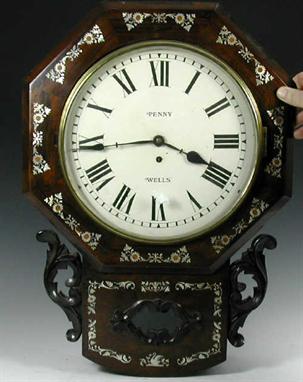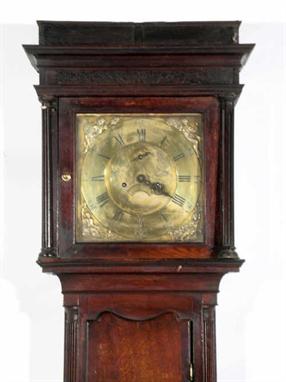Hugh Spence, Huntly. An early 19th century oak 8-day longcase clock, the twin train movement with anchor escapement, the white enamel dial with subsidiary seconds and date dials, painted with flowers to the spandrels and a lady in a field to the arch, the hood with swan neck pediment centred by a brass eagle and ball finial above brass mounted columns, the case with arched moulded trunk door between quarter column angles, on plinth base, 214cm high
66969 Preisdatenbank Los(e) gefunden, die Ihrer Suche entsprechen
66969 Lose gefunden, die zu Ihrer Suche passen. Abonnieren Sie die Preisdatenbank, um sofortigen Zugriff auf alle Dienstleistungen der Preisdatenbank zu haben.
Preisdatenbank abonnieren- Liste
- Galerie
-
66969 Los(e)/Seite
William Lee, Leicester. A late 18th century oak 8-day longcase clock, A late 18th century oak longcase clock, the twin train movement with anchor escapement, the brass dial with cast spandrels, slivered chapter ring and subsidiary seconds dial and date aperture, the hood with moulded cornice and turned columns, the case with double arched trunk door, on plinth base with bracket feet, 200cm high
An early 19th Century mahogany longcase clock, the hood having three gilt finials above turned pilasters flanking plain white enamel arched dial (width 12 inches), having Roman numerals, subsidiary seconds dial and rolling date dial, twin winding holes for a brass four pillar eight day weight driven movement striking on a bell, the trunk having arched door above a box base on bracket feet, height 215cm
An early 19th Century mahogany longcase clock, the arched hood having twin ring turned and slender reeded pilasters flanking a painted arched dial (width 13 inches)signed 'Feltham of Harleston' with gilded chapter ring, having Arabic numerals, subsidiary seconds dial and date dial, the corners and arch painted with a variety of shells, twin winding holes for a brass eight day four pillar twin train weight driven movement striking on a bell, the trunk having an arched panelled door with ebony stringing within canted reeded corners to a box base with crossbanding and raised on bracket feet, height 223cm
A George III oak longcase clock, having an arched hood above twin three-quarter turned reeded pilasters flanking arched brass dial (width 12 inches), having Tempest Fugit rocking automaton to the arch, Roman and Arabic numerals, the face engraved with a classical figure scene, lilies and flowers, subsidiary seconds dial and date aperture, signed 'Richard Reed, Chelmsford', twin winding holes for a brass five pillar eight day weight driven movement striking on a bell, the trunk having an arched panelled door, raised on a box base with plinth, height 217cm
A George III oak and walnut crossbanded longcase clock, circa 1780, the square hood with ogive cornice and blind fretwork carved frieze above a square glazed door enclosing a 12" brass dial with roman numerals, subsidiary seconds dial and date aperture and marked 'Sam Harley, Salop', with foliate engraved centre and figural spandrels representing the seasons, eight day movement striking on a bell, above an ogive moulding and shaped top, crossbanded three quarter length trunk door flanked by fluted quarter columns, a further ogive moulding and crossbanded base board and later plinth, distressed, 88" high.
An oak and walnut crossbanded longcase clock, 18th century, the ogive cornice above a blind fret carved frieze and square glazed door flanked by gilded pilasters enclosing a 12" brass dial with roman numerals, subsidiary seconds dial and date aperture and marked 'Ralph Cappor, Salop', cherub mask spandrels, eight day movement striking on a bell above an ogive moulding and full length crossbanded trunk door, further moulding and plain base board and on bracket feet, old damage and repair, 81" high
Japanese Shaku-dokei (ruler clock), 19th Century (Edo/Meiji), the glazed canopy enclosing a brass clock with turned columns and engraved front plate, over a wooden cased black lacquered perpetual dial with gilt numerals, single weight driven movement, the whole suspended on a free standing bracket with square base, height 20ins, trunk width 3 1/4ins.
David Craig, Ford Pathhead (Midlothian), (clock maker), an oak eight day longcase clock, circa 1780 with later carved case, swan neck pediment with brass floral appliques over tapered reeded columns flanking an arched 13ins brass dial, signed to the arch within dolphin serpent spandrels, silvered chapter ring with Roman numerals within masked spandrels, foliate engraved centre with subsidiary seconds and date dial, the movement striking on a bell the trunk carved in the French taste with fluted chamfers flanking a door carved with shell and trompe l'oeil over a box base further carved with foliate embellished cartouche, raised on shaped bracket feet, height, 82ins
Welsh oak and mahogany eight day longcase clock, circa 1820, swan neck pediment with three brass ball finials over reeded square section columns flanking a painted arched 12 1/2ins dial, with floral and strawberry spandrels and a rose to the arch, the centre painted with cherries, within Roman numerals, outer minutes, subsidiary seconds dial and date aperture, movement striking on a bell, the trunk with a mahogany banded door within reeded quarter pilasters raised on a plinth and box base, height 85ins
Jones, Llanerchnmead (clock maker), a Welsh oak and mahogany eight day longcase clock, circa 1810, architectural pediment over two turned columns flanking a 13ins square painted dial with wild rose and strawberry spandrels, signed to the centre within Roman numerals, subsidiary seconds dial and date aperture, the movement striking on a bell, the trunk with a cross banded door within quarter reeded columns raised on a box base, also crossbanded, height 83 1/2ins
An early 19th century oak longcase clock, the hood with broken swan neck pediment and central brass globe above a crossbanded long trunk door, box base and plinth, the 31 cms square dial with floral spandrels, Roman numerals, seconds subsidiary dial and calendar aperture, the eight day movement striking on a bell, 219 cms high.
A 19th century mahogany longcase clock, the arched hood with rope twist columns above a short trunk door, box base and plinth, the 35.5 cms dial painted with a landscape to the arch and cottage spandrels, with Roman numerals, calendar aperture and seconds dial, the eight day movement striking on a bell.
A 19th century oak and mahogany longcase clock, the hood with broken swan neck pediment and baluster columns above a short trunk door with shaped top, box base and bracket feet, the 31 cms square dial with Roman numerals and calendar aperture, inscribed 'David Jones Newtown', with a 30 hour movement.
A George III oak longcase clock, by William Porthouse, Penrith, the hood with swan neck pediment and fluted columns, the brass dial with calendar aperture, eight day rack striking movement with anchor escapement, the trunk with inlay, fluted quarter columns and panel plinth, upon bracket feet, (232cm tall).
A George III and later painted and decorated longcase clock, the eight-day movement having 12ins painted break-arch Roman dial, with subsidiary seconds and date aperture, decorated with Mediterranean scenes, the case having pagoda top and break-arch trunk door on plinth base, decorated with prints of lovers in gilt borders, H 243cm W 48cm
A part 18th Century thirty hour Longcase Clock, signed Henry Deykin of Worcester, Number 895, the mahogany case with square hood and overhanging cornice to free standing columns over a shaped trunk door and plinth base, the 9 3/4" brass dial with foliate urn spandrels to a silvered Roman chapter ring with inside quarters track and fleur de lis half hour markers to a matted centre with single pierced steel hand and applied name plate, the plated movement with four knopped pillars and anchor escapement, strike on a bell (associated), height 76"
A glasgow school WALNUT LONGCASE CLOCK, having a circular brass dial with black painted Arabic numerals, eight day chiming movement, the case having a flared cornice above a convex glass and glazed trunk, the lower section having an indented panel with applied linear decoration, on a splayed plinth and bracket base, 75in. (192cms) high
A late 18th Century stripped pine longcase clock, the 12ins arched painted dial with classical figures to the arch and floral spandrels, Roman and Arabic numerals, subsidiary seconds dial and date aperture to the eight day movement striking on a bell, contained in plain case with deep arched and moulded overhanging cornice and turned pillars to hood, arched trunk door and plinth base, 81ins high
A late George III oak and mahogany longcase clock, circa 1790, the 14" dial with subsidiary seconds dial and date aperture beneath a moonphase movement painted with religious scenes to the spandrils and inside the chapter ring, with an eight day hourly striking movement, the hood with broken swan neck pediment, arched glazed door flanked by turned columns, the trunk with ogee door with crossbanded decoration, on a base with a crossbanded panel, raised on short bracket feet, height 229cm .
An early 19c mahogany and oak longcase clock with caddy top, brass finials, fluted columns to the side of the hood over a trunk with fluted sides, shaped door, cross-banded base on bracket feet; the white painted dial inscribed "Tate Winterton" and with balloon and sailing vessels to the top of the face, jewelled decorative spandrels, Arabic numerals and seconds and date dials, enclosing an eight-day movement, 230 cms. overall.
A George III mahogany stick barometer, with broken pediment over rectangular silvered scale calibrated in inches, with vernier and alcohol farenheit thermometer, signed 'P. Martinelli, London', the trunk with exposed tube within chevron borders and caddy moulded angles, the base with domed cistern cover, 96cm high.
A Bristol mahogany thirty-hour longcase clock, circa 1760, the two-handed four-pillar outside countwheel bell-striking movement with 11 inch square brass dial applied with silvered Roman numeral chapter ring with Arabic minutes and signed 'Wasbrou' & Thomas, Bristol' to lower edge, with female mask spandrels and foliate engraved calendar aperture to the matted centre, in a swan neck pedimented case with later bobbin turned hood pilasters, rectangular trunk door and on plain plinth base with bracket feet, 213cm high.
An early 19th century mahogany crossbanded and inlaid oak eight-day longcase clock, the four-pillar rack and bell striking movement with 13 inch white painted Roman numeral break-arch dial with subsidiary seconds dial and signed 'Farmer, Stockton on Tees' to centre, with vase of flowers polychrome decorated spandrels and country landscape view to arch, in a swan neck pedimented case over fluted hood pilasters, inlaid throat panel and shaped-top trunk door flanked by canted angles, on banded plinth base with bracket feet, 225cm high.
A South Gloucestershire crossbanded mahogany eight-day longcase clock, with penny moon circa 1840, the four-pillar rack and bell striking movement with 13 inch single-sheet silvered brass break-arch Roman numeral dial, the centre with subsidiary date and seconds dials and signed 'John Gough, Thornbury', the arch with penny moon beneath double-ended age pointer, in a break-arch pedimented case with short trunk door flanked by Corinthian quarter columns, on quarter veneered plinth base with bracket feet, veneer losses to case, 212cm high.
An oak cased eight-day longcase clock, the four-pillar rack and bell striking movement with 12 inch brass square dial with arch calendar aperture, recessed seconds dial and signed 'Henry Jory?, Hale' to centre within an applied Roman numeral chapter ring with Arabic minutes and string of pearls pattern spandrels to angles, in a carved oak case with shaped crest and reeded pilasters to hood over short trunk door and plinth base with bracket feet, movement and dial circa 1780, 222cm high.
-
66969 Los(e)/Seite








































